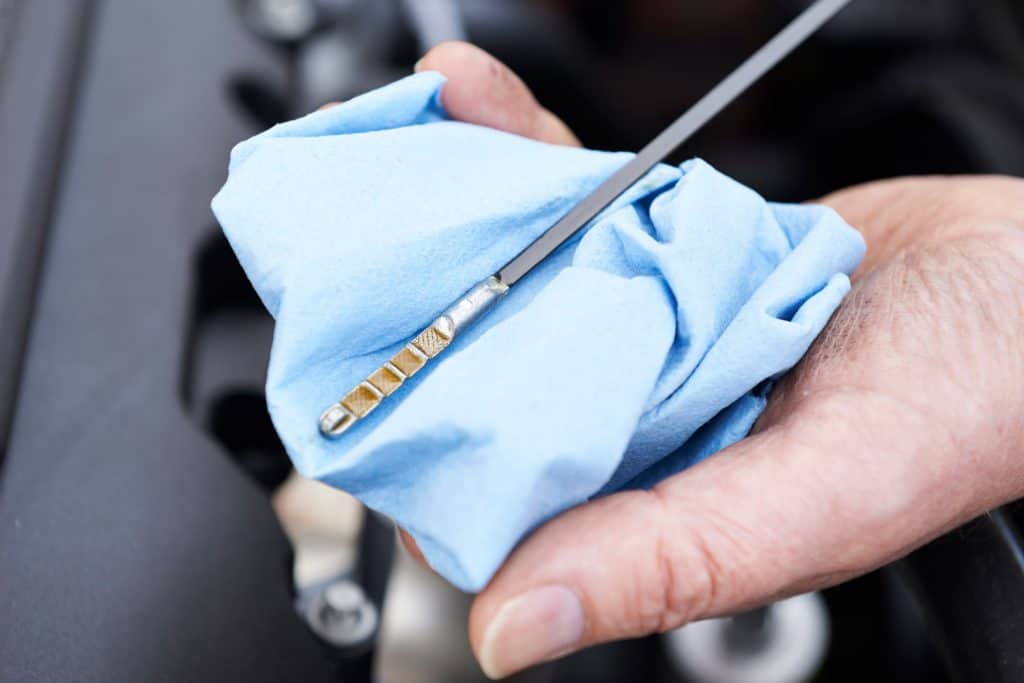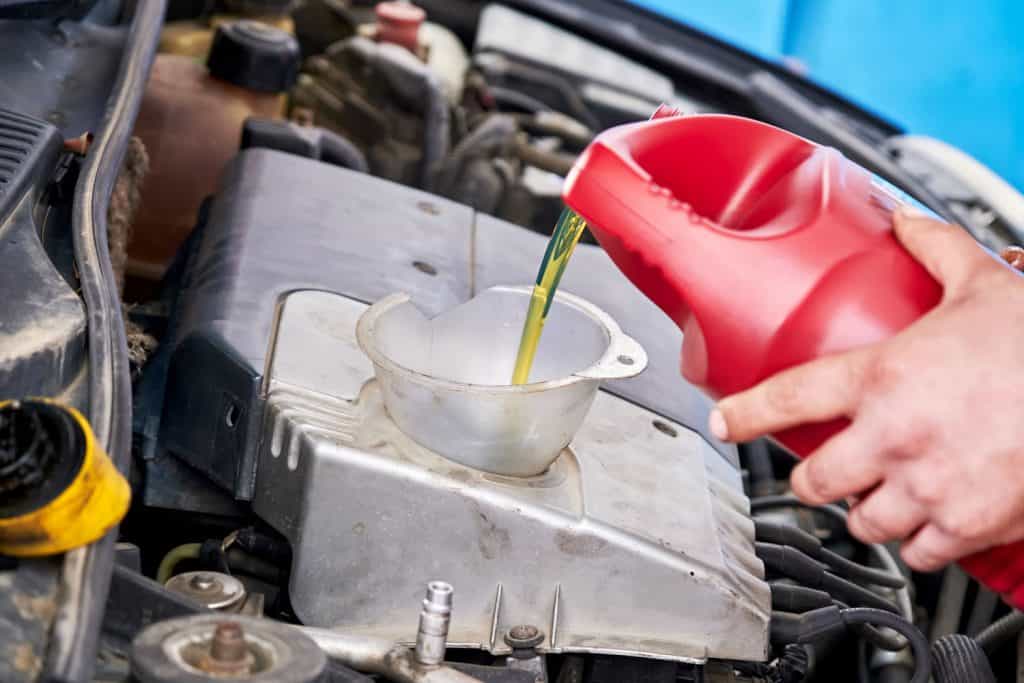Figuring out how to maintain your car can be challenging to say the least. Do you want to add oil to your vehicle but don't know whether you should leave it running or turn it off? Well, we've done plenty of research and have the answer here for you.
Whether you're simply topping off on oil or if you're adding several quarts after an oil change, you should ensure that the engine is shut off during the process. If you're topping off on oil, it's also recommended to give the engine several minutes to cool off before adding oil so you don't burn yourself.
As we begin, we will cover all things vehicle maintenance and discuss how to add oil to your car correctly. Whether you drive a truck, sedan, or SUV, we're here to steer you in the right direction. With that said, let's dive right into this topic!

How Often Should I Add Oil To My Car?

The only time you should add oil to your engine is if you notice that it's burning a significant amount of oil in between oil changes.
Simply shut off the engine and take a look at the oil dipstick under the hood after waiting about 20 minutes for the oil to settle; if the oil line is below the safe zone, it's time to add oil.
Add oil through the oil fill port in small amounts, and frequently check the dipstick until the oil line is in the safe zone. Be sure to park on a level surface during the process to ensure an accurate reading.
How Long Does It Take For Oil To Settle?

If you're concerned about your engine's oil level and plan on checking it, it's important to give the oil enough time to settle to ensure that the dipstick reading is correct. Castrol recommends waiting about 20 minutes for the engine oil to settle.
Do I Have To Wait For My Engine To Cool Before Adding Oil?
It's a good idea to let your car's engine cool down before adding more oil. Although this isn't technically required, allowing your engine to cool for 5-10 minutes can make adding oil much safer.
You can also try checking and adding oil before you start driving, which will ensure your vehicle's engine isn't hot enough to burn you. Again, this comes down to expertise and comfort level, but we recommend giving your engine a few minutes to cool before going under the hood.
You may also like: Why Do Cars Need Oil? [And What Happens If You Don’t Change Oil]
Can I Start My Car After Adding Oil?
Yes, you can start your car and drive after adding oil. As long as the oil filler cap is secure, it's perfectly fine to quickly top off on oil if needed and get back on the road.
Is It OK To Add New Oil To Old Oil?
It's generally perfectly fine to add new oil to your existing oil between changes provided the engine is low on oil.
However, you also want to be mindful of the type of oil you add to your engine; stick with your car manufacturer's recommendation. Adding different oils into your engine can result in damage, so it's best to use the same brand/formula per refill.
How Do I Know When To Change My Engine Oil?
In general, you want to change the oil in your car at least once per year. Luckily, if you drive a modern vehicle, it will more than likely provide you with an alert when it's time to change the oil.
If you don't remember the last time you had an oil change, there are some things that will indicate that you need one. These typically include:
- Excess vehicle exhaust
- Increased engine noise
- Falling oil level
- Irregular oil texture
- Flashing engine light
- Shaking while idling
- Ticking sounds when starting
Although these are just some of the common signs your car is ready for an oil change, it's always a good idea to take it into the shop for a professional opinion.
You may also like: Do Car Dealerships Change Oil Before Selling?
Should I Change Oil Or Add Oil?
There are a few things to consider when it comes to changing versus adding oil to your car. Most importantly, if it's been more than 12 months since your last oil change, it's best to get that done.
As we covered earlier, adding oil to your car's engine is a good way to keep it running efficiently if it needs it, but this doesn't eliminate the need for an oil change. On top of that, simply adding oil instead of changing it won't properly lubricate your engine, which in turn can damage your vehicle.
Does Car Oil Go Bad?
Although it doesn't expire like a carton of milk, car oil won't be effective past a certain amount of miles. This tends to vary depending on your vehicle's make and model, but expect to need new oil every 3,000-7,500 miles you drive or once a year, whichever comes first.
Car oil can also go bad if it sits in a vehicle that isn't driven often, so it's a good idea to take an idle vehicle on a joy ride a few times per month. Again, every can of oil you put into your car will have an expiration date/period, so if all else fails, check the label.
Is It Better To Change Oil Every 6 Months?
Depending on how much you drive, getting an oil change every 6 months may be better. As mentioned, it's recommended to change the oil in your vehicle every 3,000-7,500 miles, so this will vary for everyone.
It's also possible to need even more frequent oil changes, so if you drive long distances regularly, expect to need new oil every 3-4 months. Again, everybody is different, so try to create a schedule that works for you and your vehicle.
Can You Add Too Much Oil To A Car?

It is possible to add too much oil to your car. When this happens, the level in your vehicle's oil pan becomes too high, which can create excessive pressure inside your engine.
Most times, this will result in a leak from your engine's gaskets and seals, which can be expensive to repair. Overfilling an engine can also lead to long-term damage, so try to keep it at the recommended amount.
How Do You Know If Your Car Has Too Much Oil?
If you've put too much oil in your car, there are some things that will indicate it. They include:
- Oil leaking from your vehicle
- The smell of burning engine oil
- Smoke coming from the engine compartment
- Smoke/black exhaust from the tailpipe
- Unusual noises coming from the engine
Of course, these are just some of the most common symptoms of an overfilled engine, so if you notice any irregularities, we recommend having your car checked out by a professional.
How Long Should I Let My Car Run After An Oil Change?
Ideally, you want to let your car run for about 2-3 minutes after an oil change. Having your engine run for a few minutes will circulate the new oil, which is good to do before driving.
It's also a good idea to leave your car running to ensure that the engine doesn't leak oil from the oil filter or the oil drain. That said, some mechanics will do this for you post-oil change, but it's always good to inspect your car yourself to make sure everything is in order.
To Wrap It All Up

Whether you like to add oil to your car between changes or have never thought to do so, it's essential to know how to do it safely. You want to have your vehicle parked on level ground and turned off when adding new oil to it so you don't hurt yourself.
It's also a good idea to let your engine cool for 5-10 minutes before getting under the hood. In general, we recommend adding oil to your car before you drive it so you don't have to worry about getting burned.
Regardless, remember to schedule an oil change at least every 12 months, and don't forget to let your car run for 2-3 minutes post-change to circulate the new oil through the engine.
